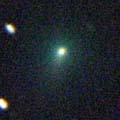
|
New comet discovered on the SWAN images. Although it had been unobservable for a while, it was about 10.0 mag in SOHO LASCO images on Aug. 15, almost bright as expected. Now it is finally appearing at dawn. It was about 7.5 mag on Sept. 16 (Martin Mc kenna), bright as expected. It will keep 7 mag until the end of October. In the Northern Hemisphere, it locates low in the morning sky in September. But it will turn to locate in the evening sky after early October, then it keeps observable in the evening sky until early January while fading gradually. In the Southern Hemisphere, it cannot be observable until next April when it becomes fainter than 15 mag.
Date(TT) R.A. (2000) Decl. Delta r Elong. m1 Best Time(A, h)
Sept.16 11 0.92 24 10.0 1.649 0.820 22 7.7 4:35 (256,-23)
Sept.23 11 26.56 28 6.6 1.499 0.790 29 7.4 4:24 (253,-26)
|
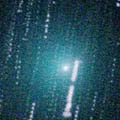
|
Recovered after 117 year blank since 1889. This time it comes closer to the earth than at the discovery, and observable in good condition. It brightened rapidly in mid July and reached to 8 mag. Then it keeps bright at 8 mag with a large diffuse coma until early September. In the Northern Hemisphere, it keeps locating very high in the evening sky until winter when it becomes too faint. It moves around the Northern Pole. So it will be observable all night until November, although it becomes low in the morning. It will be bright visually in September. However, it will fade out rapidly after October.
Date(TT) R.A. (2000) Decl. Delta r Elong. m1 Best Time(A, h)
Sept.16 17 37.53 65 43.9 0.588 1.145 87 9.4 19:15 (172,-12)
Sept.23 18 3.81 68 46.7 0.611 1.178 90 9.9 19:21 (172,-15)
|
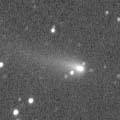
|
Now it is 11.1 mag (Sept. 14, Jakub Cerny). It is somewhat fainter than this ephemeris, however, it is well condensed and easy to see. It will be brightening rapidly after this, and will reach to 9 mag from autumn to winter, and observable in its best condition. It keeps 14 mag still in 2007 March, so it keeps visible visually for a long time.
Date(TT) R.A. (2000) Decl. Delta r Elong. m1 Best Time(A, h)
Sept.16 1 56.70 14 42.5 0.877 1.772 140 10.3 2:18 (180, 40)
Sept.23 2 1.47 14 0.4 0.823 1.750 146 10.1 1:56 (180, 41)
|
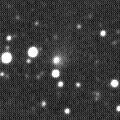
|
It is bright as 12.6 mag and visible visually (June 21, Juan Jose Gonzalez). In the Northern Hemisphere, it locates rather low in the evening. It will be too low at dusk to observe in October. But it will be getting higher in the morning sky after December. It keeps 13 mag until 2007 March, so it will be visible visually for a long time.
Date(TT) R.A. (2000) Decl. Delta r Elong. m1 Best Time(A, h)
Sept.16 14 32.85 -1 4.8 2.736 2.145 44 13.0 19:15 (104, 20)
Sept.23 14 39.14 0 17.6 2.783 2.115 40 13.0 19:21 (101, 14)
|
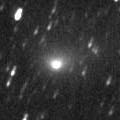
|
It reached up to 10.3 mag on July 7 (Juan Jose Gonzalez). Then it is fading gradually. Now it is 12.6 mag (Sept. 11, Walter Ruben Robledo). It had been very low, only about 15 degree high in the Northern Hemisphere. But it will get higher gradually after this. However, it will be too faint to see visually soon.
Date(TT) R.A. (2000) Decl. Delta r Elong. m1 Best Time(A, h)
Sept.16 20 10.72 -36 33.1 1.083 1.831 122 13.2 20:30 ( 0, 89)
Sept.23 20 20.06 -35 13.8 1.167 1.864 118 13.5 20:12 ( 0, 90)
|

|
A small outburst occured in late August, and it was visible visually, bright and strongly condensed, in early September. Since it appeared in the morning sky in early July, it has been bright as 12-13 mag and visible visually. It is observable in good condition until winter.
Date(TT) R.A. (2000) Decl. Delta r Elong. m1 Best Time(A, h)
Sept.16 4 24.56 31 15.4 5.526 5.839 103 13.5 4:35 (183, 24)
Sept.23 4 25.06 31 26.1 5.424 5.841 109 13.4 4:19 (180, 24)
|
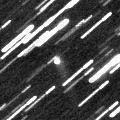
|
It had been asteroidal for about one year since 2005 July. Although the cometary activity was detected in late July in 2006, it is almost asteroidal actually. In the Northern Hemisphere, it keeps good condition after this. It keeps locating high until next spring. The light curve had been completely asteroidal so far. However, it can brighten rapidly as a comet after this, and it may reach to 11 mag in winter. However, it is still 14.8 mag and completely stellar even visually (Sept. 11, Sandor Szabo). Maybe it keeps almost asteroidal after this, and maybe it will never be brighter than 14 mag.
Date(TT) R.A. (2000) Decl. Delta r Elong. m1 Best Time(A, h)
Sept.16 21 32.40 26 52.8 1.034 1.906 138 13.9 21:50 (180, 28)
Sept.23 21 18.64 28 5.2 1.008 1.840 132 13.7 21:09 (180, 27)
|
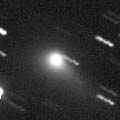
|
It had been observed at 10 mag in the evening sky from winter to spring. Although it has been unobservable since May, now it is appearing in the morning sky again. Now it is 14.5 mag (Sept. 2, Ken-ichi Kadota). It will come to locate high in October, then it will be visible visually again at 14 mag.
Date(TT) R.A. (2000) Decl. Delta r Elong. m1 Best Time(A, h)
Sept.16 9 10.40 27 23.1 3.700 3.031 42 14.1 4:35 (239, -4)
Sept.23 9 19.39 26 47.1 3.701 3.100 46 14.2 4:24 (238, -2)
|

|
It has been lost since its discovery in 1986. The condition is good in this return. In calculation, it will be 14 mag from autumn to winter. However, it was probably in outburst and brightened unexpectedly at the discovery. Actually, it must be much fainter than expected in this apparition. Although it has been listed up as an observable target since May, it has not been recovered yet. In the Northern Hemisphere, it keeps observable until it fades out in next spring. When it becomes brightest in October and November, it will move away from the Milky Way. So it will be easier to recover.
Date(TT) R.A. (2000) Decl. Delta r Elong. m1 Best Time(A, h)
Sept.16 17 57.22 -22 22.9 1.129 1.594 96 14.3 19:15 (131, 72)
Sept.23 18 10.04 -22 16.4 1.150 1.560 92 14.2 19:21 (121, 69)
|
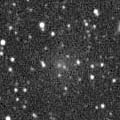
|
It will pass only 0.17 A.U. from the sun in 2007 January. Althohgh it was reported as 17 mag at the discovery, it is actually much brighter. It was 13.5 mag on Sept. 13, with a very large diffuse coma of 2.5 arcmin (Michael Jager). The comet will be brightening gradually after this, but it keeps locating low in the evening in the Northern Hemisphere. It will be observable only until early November when it becomes 12.5 mag. It is expected to reach up to 4.5 mag in January, but it is not observable at that time. After the perihelion passage, it is only observable in the Southern Hemisphere. In the Southern Hemisphere, it will appear at 8 mag in late January, then it keeps observable while fading gradually.
Date(TT) R.A. (2000) Decl. Delta r Elong. m1 Best Time(A, h)
Sept.16 16 20.60 -15 29.3 2.599 2.500 73 14.6 19:15 (109, 50)
Sept.23 16 21.48 -15 11.5 2.611 2.395 66 14.4 19:21 (103, 44)
|
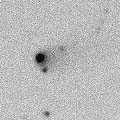
|
It has been visible at 13.5 mag for a long time since last autumn until spring. Now it is not observable. However, it will be observable in good condition again at 14.5 mag in winter.
Date(TT) R.A. (2000) Decl. Delta r Elong. m1 Best Time(A, h)
Sept.16 11 44.47 28 45.4 6.211 5.326 26 14.4 19:15 (106,-30)
Sept.23 11 51.44 27 57.3 6.205 5.339 27 14.4 4:24 (256,-31)
|
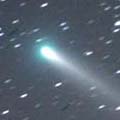
|
It reached to 6 mag at best in early May at the remarkable approach to the earth, when it became double naked eye comets with the component B around the zenith. Now it is going away from the earth and fading. It has already faded down to 13.0 mag (Aug. 22, Seiichi Yoshida). It will be too faint to see visually soon. The component B has faded out rapidly since June, and already so faint, fainter than 17 mag.
Date(TT) R.A. (2000) Decl. Delta r Elong. m1 Best Time(A, h)
Sept.16 1 38.62 -16 48.9 0.713 1.647 146 14.7 2:01 (180, 72)
Sept.23 1 25.17 -16 57.8 0.757 1.713 152 15.1 1:20 (180, 72)
|
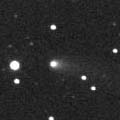
|
It is bright as 13.7 mag and visible visually (Aug. 22, Seiichi Yoshida). It keeps locating at the same altitude until December. But it will be too faint to see visually in October.
Date(TT) R.A. (2000) Decl. Delta r Elong. m1 Best Time(A, h)
Sept.16 22 15.29 -23 44.2 2.386 3.306 151 14.8 22:33 (180, 79)
Sept.23 22 11.82 -23 44.1 2.448 3.319 144 14.9 22:03 (180, 79)
|

|
It was missed in 1999 due to the bad condition. The condition is good in this return. It will reach to 13.5 mag in November. Although it is too low in the Northern Hemisphere now, it locates high in the Southern Hemisphere. It must be already bright as 15 mag, but it has not been recovered yet. In the Northern Hemisphere, it will be getting higher gradually after mid October.
Date(TT) R.A. (2000) Decl. Delta r Elong. m1 Best Time(A, h)
Sept.16 17 34.92 -49 8.7 0.927 1.395 92 15.5 19:15 ( 40, 70)
Sept.23 17 51.50 -48 12.7 0.916 1.345 88 15.2 19:21 ( 46, 68)
|

|
It is observable in good condition at 15 mag in September and October.
Date(TT) R.A. (2000) Decl. Delta r Elong. m1 Best Time(A, h)
Sept.16 7 45.97 66 16.2 0.517 1.002 74 15.5 4:35 (200,-19)
Sept.23 6 18.56 73 45.7 0.510 1.114 88 15.3 4:24 (188,-20)
|

|
It was in major outburst unexpectedly and reached to 10.5 mag in its last appearance in 1999. It was already recovered in 2005 October. But it has not been observed for about 1 year since that. So the current brightness is quite uncertain. It will appear in the morning sky at 15.5 mag soon, then it will fade out gradually. But actually, it can be much fainter than this ephemeris.
Date(TT) R.A. (2000) Decl. Delta r Elong. m1 Best Time(A, h)
Sept.16 10 2.51 15 0.4 2.637 1.784 25 15.4 4:35 (256, -6)
Sept.23 10 19.51 13 3.5 2.621 1.796 27 15.5 4:24 (258, -5)
|
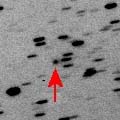
|
It will be observable at 15.5 mag for a long time from September to January. However, it was 17.3 mag on Aug. 24 (Ernesto Guido and Giovanni Sostero), somewhat fainter than this ephemeris.
Date(TT) R.A. (2000) Decl. Delta r Elong. m1 Best Time(A, h)
Sept.16 7 59.73 22 0.4 1.915 1.578 55 15.7 4:35 (232, 12)
Sept.23 8 18.86 19 53.8 1.877 1.581 57 15.7 4:24 (234, 13)
|
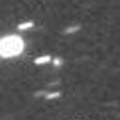
|
It is outside of Jupiter's orbit, so it keeps observable for a long time. Now it is 15.8 mag (June 2, Ernesto Guido and Giovanni Sostero). In 2006, it is still faint and locating somewhat low. But in 2007 and 2008, it is expected to be bright as 14.5-15 mag. It will locate high at that time, so it may be visible visually.
Date(TT) R.A. (2000) Decl. Delta r Elong. m1 Best Time(A, h)
Sept.16 18 40.48 -22 14.2 6.237 6.592 106 15.8 19:15 (164, 77)
Sept.23 18 37.46 -21 56.5 6.336 6.567 98 15.8 19:21 (136, 73)
|
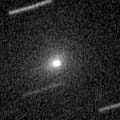
|
It brightened much more rapidly than expected after late April, and reached to 9.5 mag on June 15 (Willian Souza). Then it has been fading very rapidly. It is reported bright as 12.7 mag visually still now (Aug. 27, Juan Jose Gonzalez), however, it will be too faint to see visually soon. CCD observers reported that it has already fainter than 16 mag. Although it keeps higher than 20 deg in the evening sky until November, it may be too faint to observe soon even by CCD observers.
Date(TT) R.A. (2000) Decl. Delta r Elong. m1 Best Time(A, h)
Sept.16 16 32.93 -16 17.7 1.519 1.609 76 16.1 19:15 (111, 53)
Sept.23 16 54.58 -17 37.3 1.625 1.669 74 16.7 19:21 (107, 52)
|

|
It was observed as 12 mag in spring. It was diffuse visually, but bright and enjoyable with a large telescope. However, it has already faded down to 16.2 mag (Aug. 14, Mitsunori Tsumura). It keeps observable in good condition until autumn. It will be very low in November, but it will be getting higher in the morning sky after that. So it keeps observable for a long time until it becomes too faint.
Date(TT) R.A. (2000) Decl. Delta r Elong. m1 Best Time(A, h)
Sept.16 15 23.83 26 36.8 3.569 3.185 59 16.1 19:15 (133, 11)
Sept.23 15 26.90 26 15.6 3.698 3.252 56 16.3 19:21 (128, 6)
|
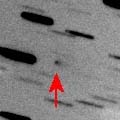
|
It was observed at 18.5 mag on Aug. 27, as bright as expected (Luca Buzzi). It will brighten very rapidly in the morning sky after this. It will reach to 13.5 mag in November and December, and will be observable in an excellent condition.
Date(TT) R.A. (2000) Decl. Delta r Elong. m1 Best Time(A, h)
Sept.16 5 54.77 2 52.6 1.499 1.726 84 16.5 4:35 (217, 45)
Sept.23 6 9.10 3 55.4 1.419 1.702 87 16.2 4:24 (216, 45)
|
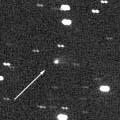
|
It kept 16.5 mag for a year and a half since early 2005. Now it is at opposition and observable in very good condition. However, it will start fading after November, and will be fainter than 18 mag at the end of 2006.
Date(TT) R.A. (2000) Decl. Delta r Elong. m1 Best Time(A, h)
Sept.16 0 20.18 47 49.0 3.037 3.745 128 16.4 0:43 (180, 7)
Sept.23 0 11.52 45 52.4 3.012 3.778 133 16.5 0:06 (180, 9)
|
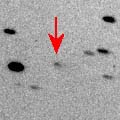
|
It was 17.6 mag on July 23 (Filip Fratev). It will brighten after the perihelion passage. It will reach to 15.5 mag and will be observable in good condition from November to January.
Date(TT) R.A. (2000) Decl. Delta r Elong. m1 Best Time(A, h)
Sept.16 5 19.36 15 2.4 1.546 1.884 92 16.9 4:35 (200, 38)
Sept.23 5 30.38 15 6.0 1.494 1.897 96 16.7 4:24 (198, 38)
|

|
It was observed at 17 mag in spring. It will be observable in good condition at 17 mag again in autumn. However, no observations have been reported recently, although it already locates high in the morning. It will be fainter than 18 mag in December.
Date(TT) R.A. (2000) Decl. Delta r Elong. m1 Best Time(A, h)
Sept.16 6 0.91 20 38.9 1.856 1.996 82 16.8 4:35 (209, 29)
Sept.23 5 48.11 18 10.7 1.731 2.039 92 16.8 4:24 (202, 34)
|
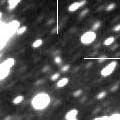
|
It keeps 17 mag for a long time after this until the end of 2007. It will be observable in good condition in 2006 autumn and 2007 autumn.
Date(TT) R.A. (2000) Decl. Delta r Elong. m1 Best Time(A, h)
Sept.16 19 23.20 45 35.9 3.394 3.805 106 17.0 19:42 (180, 9)
Sept.23 19 25.05 44 38.0 3.397 3.783 105 16.9 19:21 (179, 10)
|
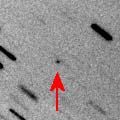
|
Although it was so faint as 20.7 mag on Aug. 2 (P. Birtwhistle), it brightened very rapidly up to 17.9 mag on Aug. 28 (Filip Fratev). The condition of this apparition is excellent. It will brighten furthermore rapidly after this, and it is expected to reach to 16 mag in October and November.
Date(TT) R.A. (2000) Decl. Delta r Elong. m1 Best Time(A, h)
Sept.16 4 5.89 14 52.4 0.865 1.539 110 17.3 4:27 (180, 40)
Sept.23 4 18.12 18 34.5 0.803 1.517 113 17.0 4:12 (180, 37)
|
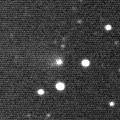
|
It was bright as 15 mag in 2004 and 2005. Now it is far away from the sun, but it is still observed at 17 mag in 2006.
Date(TT) R.A. (2000) Decl. Delta r Elong. m1 Best Time(A, h)
Sept.16 1 3.02 -15 14.1 3.129 4.062 154 17.1 1:25 (180, 70)
Sept.23 0 58.74 -15 42.9 3.128 4.079 158 17.1 0:53 (180, 71)
|
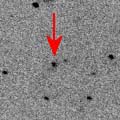
|
It is outside of Jupiter's orbit. So it keeps 16.5-17.5 mag for a long time until 2008. In 2006, it keeps observable in good condition until November.
Date(TT) R.A. (2000) Decl. Delta r Elong. m1 Best Time(A, h)
Sept.16 20 51.92 -14 37.9 5.449 6.236 138 17.1 21:10 (180, 70)
Sept.23 20 46.88 -14 20.5 5.522 6.220 130 17.1 20:38 (180, 69)
|

|
It will be observable at 17 mag in good condition in September and October. Then it will fade out rapidly, and will be fainter than 18 mag in December.
Date(TT) R.A. (2000) Decl. Delta r Elong. m1 Best Time(A, h)
Sept.16 3 22.66 15 57.0 1.962 2.619 120 17.1 3:44 (180, 39)
Sept.23 3 22.92 15 1.1 1.914 2.647 127 17.1 3:17 (180, 40)
|

|
It was observed at 17 mag in 2005 summer. It will reach to 17 mag again in 2006 summer. However, no observations have been reported yet in 2006.
Date(TT) R.A. (2000) Decl. Delta r Elong. m1 Best Time(A, h)
Sept.16 22 26.87 -13 52.7 2.399 3.362 160 17.2 22:45 (180, 69)
Sept.23 22 23.51 -14 20.6 2.451 3.372 152 17.2 22:14 (180, 69)
|
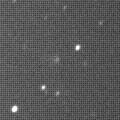
|
It reached up to 16 mag in 2005 summer in the Southern Hemisphere. It will keep 17.5 mag until January after this. Then it will be fainter than 18 mag in February.
Date(TT) R.A. (2000) Decl. Delta r Elong. m1 Best Time(A, h)
Sept.16 5 48.19 -22 7.9 4.539 4.611 87 17.3 4:35 (244, 66)
Sept.23 5 49.49 -22 24.4 4.496 4.645 92 17.3 4:24 (239, 69)
|
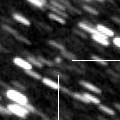
|
It will reach to 14.5 mag in 2007 summer, but it will be observable only in the Southern Hemisphere at that time. Now it is 17.2 mag (Aug. 27, J. Young). In the Northern Hemisphere, it keeps observable at 17.5 mag in good condition until autumn.
Date(TT) R.A. (2000) Decl. Delta r Elong. m1 Best Time(A, h)
Sept.16 19 30.79 1 54.6 4.563 5.127 119 17.4 19:49 (180, 53)
Sept.23 19 27.55 0 33.6 4.617 5.080 112 17.4 19:21 (179, 55)
|

|
It reached to 6 mag in 2004. It had been visible visually until January. It has already faded down to 17.2 mag (Aug. 9, Ken-ichi Kadota). It will be fading slowly around 17-18 mag until December.
Date(TT) R.A. (2000) Decl. Delta r Elong. m1 Best Time(A, h)
Sept.16 3 0.05 -2 23.2 7.135 7.801 128 17.4 3:22 (180, 57)
Sept.23 2 56.85 -2 43.6 7.110 7.858 135 17.4 2:51 (180, 58)
|
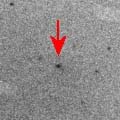
|
It keeps observable at 17 mag in good condition until October.
Date(TT) R.A. (2000) Decl. Delta r Elong. m1 Best Time(A, h)
Sept.16 23 33.72 -6 4.5 1.617 2.622 176 17.4 23:51 (180, 61)
Sept.23 23 28.46 -5 51.4 1.651 2.646 170 17.5 23:19 (180, 61)
|

|
It was observed at 17 mag in late 2005. In 2006, it will be observable at 17.5 mag in autumn.
Date(TT) R.A. (2000) Decl. Delta r Elong. m1 Best Time(A, h)
Sept.16 2 35.63 24 28.0 4.706 5.386 128 17.5 2:58 (180, 30)
Sept.23 2 27.21 24 14.3 4.626 5.400 136 17.5 2:22 (180, 31)
|
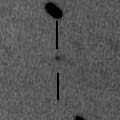
|
The perihelion passage is in 2008. It will be observable for several years after this at around 17 mag. But it may fade out rapidly just after the perihelion passage.
Date(TT) R.A. (2000) Decl. Delta r Elong. m1 Best Time(A, h)
Sept.16 4 52.67 11 12.5 4.617 4.886 99 17.7 4:35 (193, 43)
Sept.23 4 54.13 11 8.8 4.501 4.873 105 17.6 4:24 (188, 43)
|

|
It will reach to 17 mag in autumn and winter.
Date(TT) R.A. (2000) Decl. Delta r Elong. m1 Best Time(A, h)
Sept.16 4 43.67 44 44.1 3.669 3.919 96 17.8 4:35 (185, 10)
Sept.23 4 47.33 45 40.8 3.571 3.910 102 17.7 4:24 (183, 9)
|
|
![]()
 C/2006 P1 ( McNaught )
C/2006 P1 ( McNaught ) C/2003 WT42 ( LINEAR )
C/2003 WT42 ( LINEAR ) 73P-C/Schwassmann-Wachmann 3
73P-C/Schwassmann-Wachmann 3 117P/Helin-Roman-Alu 1
117P/Helin-Roman-Alu 1 P/1991 V1 ( Shoemaker-Levy 6 )
P/1991 V1 ( Shoemaker-Levy 6 ) (3200) Phaethon
(3200) Phaethon 52P/Harrington-Abell
52P/Harrington-Abell 114P/Wiseman-Skiff
114P/Wiseman-Skiff C/2005 L3 ( McNaught )
C/2005 L3 ( McNaught ) 41P/Tuttle-Giacobini-Kresak
41P/Tuttle-Giacobini-Kresak C/2004 B1 ( LINEAR )
C/2004 B1 ( LINEAR ) 76P/West-Kohoutek-Ikemura
76P/West-Kohoutek-Ikemura C/2005 B1 ( Christensen )
C/2005 B1 ( Christensen ) 84P/Giclas
84P/Giclas C/2006 CK10 ( Catalina )
C/2006 CK10 ( Catalina ) C/2006 M1 ( LINEAR )
C/2006 M1 ( LINEAR ) 112P/Urata-Niijima
112P/Urata-Niijima P/2004 F3 ( NEAT )
P/2004 F3 ( NEAT ) C/2005 S4 ( McNaught )
C/2005 S4 ( McNaught ) P/2005 JY126 ( Catalina )
P/2005 JY126 ( Catalina ) P/2005 L1 ( McNaught )
P/2005 L1 ( McNaught ) C/2004 L2 ( LINEAR )
C/2004 L2 ( LINEAR ) C/2006 K4 ( NEAT )
C/2006 K4 ( NEAT ) C/2003 K4 ( LINEAR )
C/2003 K4 ( LINEAR ) P/2006 H1 ( McNaught )
P/2006 H1 ( McNaught ) C/2005 R4 ( LINEAR )
C/2005 R4 ( LINEAR ) 173P/2005 T1 ( Mueller 5 )
173P/2005 T1 ( Mueller 5 ) P/2005 SB216 ( LONEOS )
P/2005 SB216 ( LONEOS )![]()



























